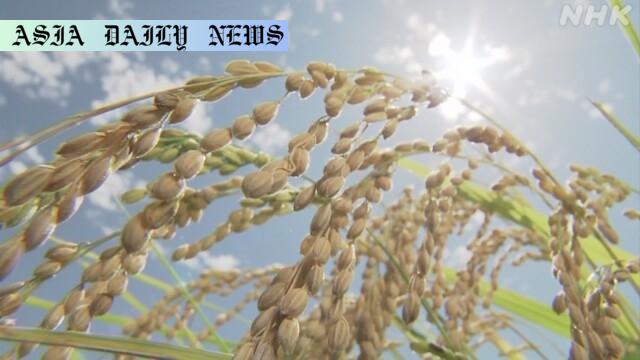Rice Crop: Japan’s agriculture minister vows swift actions to mitigate devastating drought impacts on rice yields.

Japan’s Drought Crisis and Its Impact on Rice Crop
In recent weeks, Japan has been grappling with an alarming drought that threatens one of its most vital agricultural products—rice. The Hokuriku and Tohoku regions, known for their extensive rice paddies and significant contribution to domestic food security, are experiencing an extreme shortage of rainfall. This seasonal drought has led to notable declines in water reserves, with critical infrastructure such as the Ohyachi Dam in Niigata Prefecture dropping to a concerning 6 percent of its full capacity. Authorities have suspended water outflows, compounding worries for local rice farmers.
Rice production in Japan is not merely an agricultural activity; it holds a deep cultural and historical significance. Any disruption in cultivation has far-reaching implications, affecting both Japan’s economy and its food supply. Niigata Prefecture, in particular, is a cornerstone of rice farming, and its farmers are acutely aware of how quickly poor water availability can turn into widespread crop failure. Agriculture Minister Koizumi Shinjiro has taken on the challenge of addressing these mounting concerns, promising swift and impactful actions to ensure the nation’s rice production remains stable.
Efforts to Mitigate the Crisis
Koizumi’s visit to Niigata underlines the government’s intention to actively engage with the affected communities. During his inspection of the Ohyachi Dam, farmers expressed their fears over the lack of adequate water at this crucial time in the rice growing cycle. The suspended outflows threaten the immediate future of rice crops, and water trucks have already been deployed as emergency relief. However, this is just a stopgap solution, as long-term measures are needed to safeguard the future of Japanese agriculture.
The agriculture ministry is exploring multiple strategies to mitigate the crisis. These include rerouting additional water supplies from other regions, prioritizing agricultural irrigation during drought periods, and leveraging advanced technology to improve water efficiency in farming practices. Furthermore, the government has vowed to maintain open communication channels with farmers and local communities to quickly adapt to evolving challenges. These proactive measures demonstrate the critical importance the state places on agriculture and the livelihood of its rural populations.
Broader Implications for Japan’s Economy
The scarcity of water in key rice-producing regions does not only affect farmers but resonates throughout the broader Japanese economy. Rice is a staple food, and any decline in its production could lead to price inflation for consumers and increased reliance on imported alternatives. Japan has prided itself on its self-sufficiency in rice production, which forms the backbone of agricultural exports and local consumption. Prolonged droughts like the current one are significant threats to this balance, forcing the government to implement stronger contingency measures.
Another layer of concern is the environmental impact of extreme weather patterns, increasingly linked to climate change. The drought in Niigata and similar regions highlights vulnerabilities in Japan’s agricultural infrastructure and underscores the importance of sustainability. This crisis could serve as an inflection point for adopting greener technologies and resilience strategies in farming. Whether it is through improved irrigation systems, water conservation techniques, or climate-resistant crop varieties, this ongoing challenge presents an opportunity to reimagine Japanese agriculture for a more sustainable future.
Commentary
The Critical Role of Rice in Japanese Culture
Rice is far more than a simple crop in Japan—it is a cornerstone of the nation’s culture, heritage, and daily sustenance. From ancient rituals to modern meals, rice has continually played a symbolically rich role in the lives of the Japanese people. Seeing this vital crop endangered by severe drought conditions reminds us of how fragile even the most deep-rooted traditions can become under environmental stresses. This crisis serves as a poignant reminder of why sustainable practices and resilience-building in agriculture are essential to preserving such cultural icons.
The Importance of Proactive Leadership
The visit by Agriculture Minister Koizumi Shinjiro to Niigata Prefecture exemplifies proactive leadership during challenging times. By witnessing the difficulties farmers face firsthand, he has sent a strong message of solidarity. In a world where government responses are often criticized for being too slow or out of touch, this direct engagement is commendable. It demonstrates a commitment to tackling problems at their root instead of relying on cosmetic measures that fail to address underlying issues.
Adapting Agriculture for a Changing Climate
This drought brings to light a much larger question: How can nations adapt agricultural practices to suit increasingly erratic weather patterns? The need for climate-smart agriculture is no longer a debate; it is a necessity. Whether through advanced irrigation technologies, diversification of crops, or research into drought-resistant rice varieties, Japan must seize this moment to redefine its agricultural future. This challenge could become an opportunity to establish Japan as a global leader in sustainable farming solutions, setting an example for others to follow.


